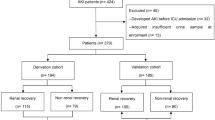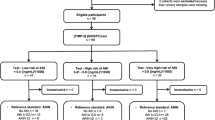Abstract
Background
Tissue inhibitor metalloproteinase-2 (TIMP-2) and insulin-like growth factor binding protein-7 (IGFBP-7) are cell-cycle arrest biomarkers that have been shown to be predictive of acute kidney injury (AKI) in critically ill adults. AKI affects a large proportion (40%) of children following cardiac surgery. The aim of this study was to describe the kinetics of TIMP-2*IGFBP-7 and test its ability to predict AKI in infants following cardiac surgery.
Methods
A multicenter prospective study was performed in infants undergoing cardiac surgery with cardiopulmonary bypass (CPB) from October 2013 to January 2015. Urine samples were obtained at baseline and at 2, 6, 12, 24, 48 and 72 h after CPB initiation. TIMP-2*IGFBP-7 concentration was measured in urine samples using the Astute 140® meter to determine a risk score for AKI. This risk score is the product of TIMP-2 (ng/mL) and IGFBP-7 (ng/mL) divided by 1000.
Results
A total of 94 infants with a mean age of 154.2 ± 85.7 days were enrolled in the study, of whom 31 (33%) subsequently developed AKI. The mean time to AKI diagnosis was 25 ± 7 h after CPB initiation. The concentration of TIMP-2*IGFBP-7 was significantly higher in patients with AKI at 12 h after CPB initiation relative to baseline (p = 0.006). At 12 h after CPB initiation patients with a TIMP-2*IGFBP-7 concentration of ≥0.78 had a threefold higher odds of developing AKI than those with a TIMP-2*IGFBP-7 concentration of < 0.78 (95% confidence interval 1.47–6.11, p = 0.001).
Conclusion
These results demonstration that TIMP-2*IGFBP-7 concentration can be used in infants to predict subsequent serum creatinine-defined AKI following CPB.



Similar content being viewed by others
References
Blinder JJ, Goldstein SL, Lee VV, Baycroft A, Fraser CD, Nelson D, Jefferies JL (2012) Congenital heart surgery in infants: effects of acute kidney injury on outcomes. J Thorac Cardiovasc Surg 143(2):368–374
Sutherland SM, Byrnes JJ, Kothari M, Longhurst CA, Dutta S, Garcia P, Goldstein SL (2015) AKI in hospitalized children: comparing the pRIFLE, AKIN, and KDIGO definitions. Clin J Am Soc Nephrol 10(4):554–561
Picca S, Ricci Z, Picardo S (2008) Acute kidney injury in an infant after cardiopulmonary bypass. Semin Nephrol 28(5):470–476
Li S, Krawczeski CD, Zappitelli M, Devarajan P, Thiessen-Philbrook H, Coca SG, Kim RW, Parikh CR, Consortium T-A (2011) Incidence, risk factors, and outcomes of acute kidney injury after pediatric cardiac surgery: a prospective multicenter study. Crit Care Med 39(6):1493–1499
Chandler HK, Kirsch R (2016) Management of the low cardiac output syndrome following surgery for congenital heart disease. Curr Cardiol Rev 12(2):107–111
Epting CL, McBride ME, Wald EL, Costello JM (2016) Pathophysiology of post-operative low cardiac output syndrome. Curr Vasc Pharmacol 14(1):14–23
Kaddourah A, Basu RK, Bagshaw SM, Goldstein SL (2016) Epidemiology of acute kidney injury in critically ill children and young adults. N Engl J Med 376(1):11–20
Faubel S, Edelstein CL (2016) Mechanisms and mediators of lung injury after acute kidney injury. Nat Rev Nephrol 12(1):48–60
Krawczeski CD, Goldstein SL, Woo JG, Wang Y, Piyaphanee N, Ma Q, Bennett M, Devarajan P (2011) Temporal relationship and predictive value of urinary acute kidney injury biomarkers after pediatric cardiopulmonary bypass. J Am Coll Cardiol 58(22):2301–2309
Kidney Disease: Improving Global Outcomes (KDIGO) AKI Work Group (2012) KDIGO clinical practice guideline for acute kidney injury.Kidney Int Suppl 2 (1):1–138
Lam NP, Kuk JM, Franson KL, Lau AH (1995) Effect of diuretic drugs on creatinine clearance determination. Ther Drug Monit 17(2):142–144
Samra M, Abcar AC (2012) False estimates of elevated creatinine. Perm J 16(2):51–52
Weber JA, van Zanten AP (1991) Interferences in current methods for measurements of creatinine. Clin Chem 37(5):695–700
Bihorac A, Chawla LS, Shaw AD, Al-Khafaji A, Davison DL, Demuth GE, Fitzgerald R, Gong MN, Graham DD, Gunnerson K, Heung M, Jortani S, Kleerup E, Koyner JL, Krell K, Letourneau J, Lissauer M, Miner J, Nguyen HB, Ortega LM, Self WH, Sellman R, Shi J, Straseski J, Szalados JE, Wilber ST, Walker MG, Wilson J, Wunderink R, Zimmerman J, Kellum JA (2014) Validation of cell-cycle arrest biomarkers for acute kidney injury using clinical adjudication. Am J Res Crit Care Med 189(8):932–939
Hoste EA, McCullough PA, Kashani K, Chawla LS, Joannidis M, Shaw AD, Feldkamp T, Uettwiller-Geiger DL, McCarthy P, Shi J, Walker MG, Kellum JA, Sapphire I (2014) Derivation and validation of cutoffs for clinical use of cell cycle arrest biomarkers. Nephrol Dial Transplant 29(11):2054–2061
Kashani K, Al-Khafaji A, Ardiles T, Artigas A, Bagshaw SM, Bell M, Bihorac A, Birkhahn R, Cely CM, Chawla LS, Davison DL, Feldkamp T, Forni LG, Gong MN, Gunnerson KJ, Haase M, Hackett J, Honore PM, Hoste EA, Joannes-Boyau O, Joannidis M, Kim P, Koyner JL, Laskowitz DT, Lissauer ME, Marx G, McCullough PA, Mullaney S, Ostermann M, Rimmele T, Shapiro NI, Shaw AD, Shi J, Sprague AM, Vincent JL, Vinsonneau C, Wagner L, Walker MG, Wilkerson RG, Zacharowski K, Kellum JA (2013) Discovery and validation of cell cycle arrest biomarkers in human acute kidney injury. Crit Care 17(1):R25
Meersch M, Schmidt C, Van Aken H, Rossaint J, Gorlich D, Stege D, Malec E, Januszewska K, Zarbock A (2014) Validation of cell-cycle arrest biomarkers for acute kidney injury after pediatric cardiac surgery. PLoS One 9(10):e110865
Pilarczyk K, Edayadiyil-Dudasova M, Wendt D, Demircioglu E, Benedik J, Dohle DS, Jakob H, Dusse F (2015) Urinary [TIMP-2]*[IGFBP7] for early prediction of acute kidney injury after coronary artery bypass surgery. Ann Intensive Care 5(1):50
Wetz AJ, Richardt EM, Wand S, Kunze N, Schotola H, Quintel M, Brauer A, Moerer O (2015) Quantification of urinary TIMP-2 and IGFBP-7 - an adequate diagnostic test to predict acute kidney injury after cardiac surgery? Crit Care 19(1):3
Honore PM, Nguyen HB, Gong M, Chawla LS, Bagshaw SM, Artigas A, Shi J, Joannes-Boyau O, Vincent JL, Kellum JA, Sapphire, I T (2016) Urinary tissue inhibitor of metalloproteinase-2 and insulin-like growth factor-binding protein 7 for risk stratification of acute kidney injury in patients with sepsis. Crit Care Med 44(10):1851–1860
Kellum JA, Chawla LS (2016) Cell-cycle arrest and acute kidney injury: the light and the dark sides. Nephrol Dial Transplant 31(1):16–22
O’Brien SM, Clarke DR, Jacobs JP, Jacobs ML, Lacour-Gayet FG, Pizarro C, Welke KF, Maruszewski B, Tobota Z, Miller WJ, Hamilton L, Peterson ED, Mavroudis C, Edwards FH (2009) An empirically based tool for analyzing mortality associated with congenital heart surgery. J Thorac Cardiovasc Surg 138(5):1139–1153
Gaies MG, Gurney JG, Yen AH, Napoli ML, Gajarski RJ, Ohye RG, Charpie JR, Hirsch JC (2010) Vasoactive-inotropic score as a predictor of morbidity and mortality in infants after cardiopulmonary bypass. Pediatr Crit Care Med 11(2):234–238
Chawla LS, Goldstein SL, Kellum JA, Ronco C (2015) Renal angina: concept and development of pretest probability assessment in acute kidney injury. Crit Care 19:93
Basu RK, Zappitelli M, Brunner L, Wang Y, Wong HR, Chawla LS, Wheeler DS, Goldstein SL (2014) Derivation and validation of the renal angina index to improve the prediction of acute kidney injury in critically ill children. Kidney Int 85(3):659–667
Menon S, Goldstein SL, Mottes T, Fei L, Kaddourah A, Terrell T, Arnold P, Bennett MR, Basu RK (2016) Urinary biomarker incorporation into the renal angina index early in intensive care unit admission optimizes acute kidney injury prediction in critically ill children: a prospective cohort study. Nephrol Dial Transplant 31(4):586–594
Meersch M, Schmidt C, Hoffmeier A, Van Aken H, Wempe C, Gerss J, Zarbock A (2017) Prevention of cardiac surgery-associated AKI by implementing the KDIGO guidelines in high risk patients identified by biomarkers: the PrevAKI randomized controlled trial. Intensive Care Med. doi:10.1007/s00134-016-4670-3
Koyner JL, Shaw AD, Chawla LS, Hoste EA, Bihorac A, Kashani K, Haase M, Shi J, Kellum JA, on behalf of the Sapphire I (2014) Tissue Inhibitor Metalloproteinase-2 (TIMP-2)IGF-Binding Protein-7 (IGFBP7) Levels Are Associated with Adverse Long-Term Outcomes in Patients with AKI. J Am Soc Nephrol 26(7):1747–1754
Parikh CR, Coca SG, Thiessen-Philbrook H, Shlipak MG, Koyner JL, Wang Z, Edelstein CL, Devarajan P, Patel UD, Zappitelli M, Krawczeski CD, Passik CS, Swaminathan M, Garg AX; TRIBE-AKI Consortium (2011) Postoperative biomarkers predict acute kidney injury and poor outcomes after adult cardiac surgery. J Am Soc Nephrol 22(9):1748–1757
Acknowledgments
Urinary TIMP-2*IGFBP-7 processing was supported by a pilot grant from the Children’s Hospital Colorado Research Institute. Special thanks to the research coordinators at each of the participating sites: Shruti Marwaha and Shalayna Woodly at Cincinnati Children’s Hospital Medical Center; Krissie Hock at Children’s of Alabama; the team of nurses in the pediatric clinical translation research center at Children’s Hospital Colorado at the University of Colorado. Finally, thanks to the Center for Acute Care Nephrology, the Heart Institute Research Core and the Division of Critical Care Medicine at Cincinnati Children’s Hospital Medical Center for their support throughout the study.
Author information
Authors and Affiliations
Corresponding author
Ethics declarations
A multi-center prospective observational study was performed in infants (≤1 year of age) after cardiac surgery with CPB from October 2013 to January 2015 following institutional review board approval. Informed consent was obtained from the parents, or parent, of each child included in the study.
Clinical Trials Information: NCT01966237, October 17, 2013
Conflict of interest
S. Goldstein reports the following disclosures: Baxter/Gambro renal Products (grant support/expert panel/consultant); Akebia (consultant); Bellco (consultant); Otsuka (steering committee for a clinical trial); La Jolla Pharmaceuticals (teering committee for a clinical trial); Astute Medical Inc (consultant); AM Pharma (consultant); Bioporto Inc. (consultant); Reata Medical Inc. (DSMB member for a study). R. Basu is part of the speakers’ bureau for Baxter Renal Solutions and a consultant for Bioporto Diagnostics. None of the other authors have any disclosures to report.
Rights and permissions
About this article
Cite this article
Gist, K.M., Goldstein, S.L., Wrona, J. et al. Kinetics of the cell cycle arrest biomarkers (TIMP-2*IGFBP-7) for prediction of acute kidney injury in infants after cardiac surgery. Pediatr Nephrol 32, 1611–1619 (2017). https://doi.org/10.1007/s00467-017-3655-y
Received:
Revised:
Accepted:
Published:
Issue Date:
DOI: https://doi.org/10.1007/s00467-017-3655-y




